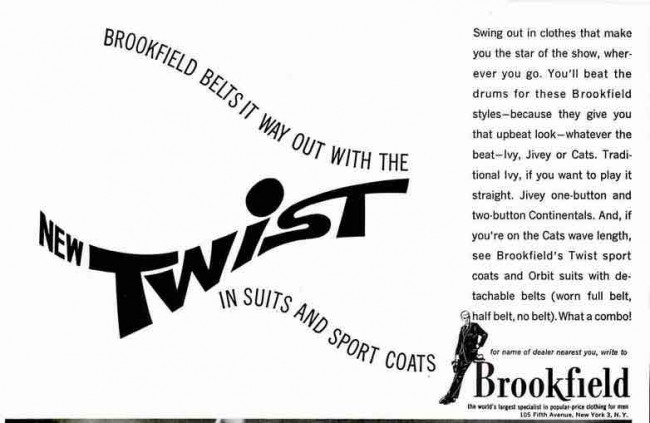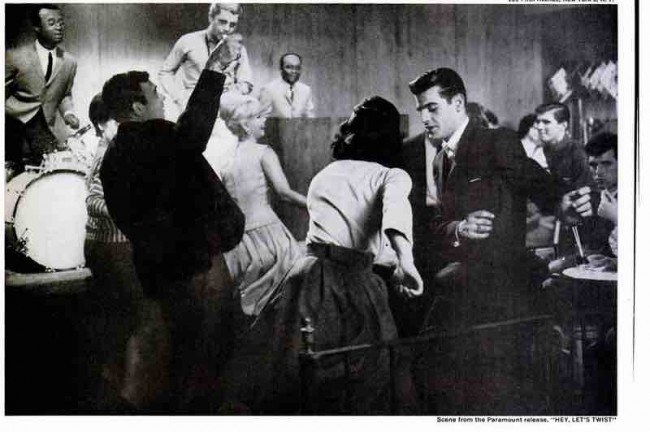1960s
Hey, Let’s Twist!
The movie so great it inspired its own line of Ivey, Jivey suits for Cats!


Original ad here.
Posted By: Paul - Tue Jan 24, 2017 -
Comments (7)
Category: Fads, Fashion, Movies, Music, Teenagers, 1960s, Dance
The Bubble
Wikipedia page.
Posted By: Paul - Fri Jan 13, 2017 -
Comments (3)
Category: Aliens, Ineptness, Crudity, Talentlessness, Kitsch, and Bad Art, Movies, Science Fiction, 1960s
Bowling is for Bored Teens!
Posted By: Paul - Fri Jan 06, 2017 -
Comments (3)
Category: Business, Advertising, Sports, Teenagers, 1960s
Niki de Saint Phalle Gun Art

We've discussed much gun-based art here before--artists shooting themselves or other objects--but I do not believe we have yet covered this instance by Niki de Saint Phalle.
A white canvas with bags of paint concealed beneath was to be fired upon, releasing the paint in random patterns. But the project proved more intractable than anticipated.

Full story here.
Posted By: Paul - Sat Dec 31, 2016 -
Comments (2)
Category: Art, Avant Garde, Guns, 1960s
Zip Code Hootenanny
Posted By: Paul - Fri Dec 23, 2016 -
Comments (1)
Category: Music, PSA’s, 1960s, Postal Services
Follies of the Madmen #299

Not sure what the slugger prowess of stews has to do with running an airline. Nowadays, they could use a baseball bat for drunk-passenger control.
Original ad here.
Posted By: Paul - Thu Dec 15, 2016 -
Comments (4)
Category: Business, Advertising, Sports, Air Travel and Airlines, 1960s
HUH? (Boolya Botten Booten Baby)
Posted By: Paul - Mon Dec 12, 2016 -
Comments (7)
Category: Jabberwocky, Scat Singing, Nonsense Verse and Glossolalia, Music, 1960s
Follies of the Madmen #298
Explanation here.
Posted By: Paul - Wed Dec 07, 2016 -
Comments (2)
Category: Business, Advertising, Products, Crowds, Groups, Mobs and Other Mass Movements, 1960s, Alcohol, Moral Panics and Public Hysteria
Space Age Bridal Creation
March 1962: Arlette Dobson and John Richard took a stroll along London's Park Lane while modeling a "space age bridal outfit."I'd like to see a wedding with the bride and groom wearing these outfits, and the bridesmaids in Gianangelli's lunar bathing suits.


Rochester Democrat and Chronicle - Mar 10, 1962
Posted By: Alex - Tue Dec 06, 2016 -
Comments (3)
Category: Fashion, 1960s, Weddings
Mystery Illustration 34

This wordless packaging was designed in 1968 to hold a very common consumer item. What was inside?
The answer is here.
And after the jump.
More in extended >>
Posted By: Paul - Mon Dec 05, 2016 -
Comments (3)
Category: Design and Designers, Graphics, Products, 1960s

| Who We Are |
|---|
| Alex Boese Alex is the creator and curator of the Museum of Hoaxes. He's also the author of various weird, non-fiction, science-themed books such as Elephants on Acid and Psychedelic Apes. Paul Di Filippo Paul has been paid to put weird ideas into fictional form for over thirty years, in his career as a noted science fiction writer. He has recently begun blogging on many curious topics with three fellow writers at The Inferior 4+1. Contact Us |




